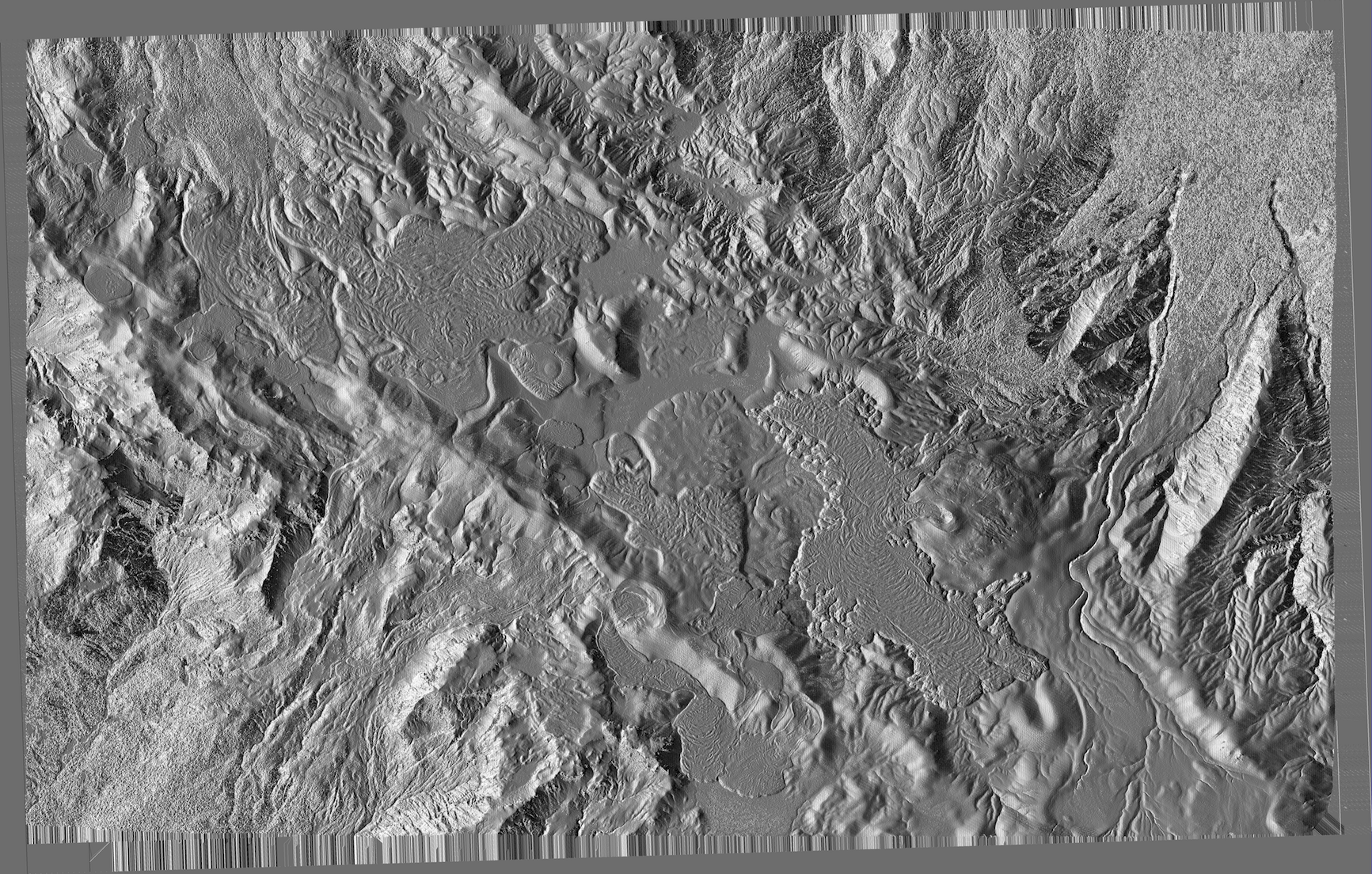Volcanology
Volcanology
Mechanics of magma storage and transport
Migration and storage of magma in the upper crust results in stress build up that can eventually lead in an eruption. However, the conditions that lead to eruptions are highly dependent on the volcano evolution, source geometry, the amount of intruded magma, the presence of fluids that can easily be remobilized in a crystal mush, among other parameters. The stress changes can be tracked with ground deformation data, and I use these observations to study magma transport and storage by means of satellite geodesy using a combination of InSAR data, numerical and analytic inverse models. I have studied magma intrusion with InSAR data at several volcanoes in the Central and Southern Andes including the famous Villarrica, Cordon Caulle, Calbuco, Chaiten, and at Yellowstone caldera.
Time series of uplift at Cordon Caulle volcano measured by Sentinel-1, COSMO-SkyMED, RADARSAT-2 and ALOS-2 ascending (asc) and descending (dsc) data after its 2011-2012 eruption (vertical black dashed line). Updated from Figure 5 in Delgado, 2020.
The black dots show the horizontal baseline change between two GPS stations in the volcano. The black line shows an exponential fit to the COSMO-SkyMED data during 2012-2015 and is strong evidence for a mechanism of magma injection in a shallow pressurized reservoir. Magma injection is likely responsible for the four pulses of ground uplift, although other mechanisms like viscoelastic relaxation and poroelastic mush extraction can also explain the deformation signals (Delgado et al., 2018; Phelps et al., 2023).

A-D) Interferograms calculated from ENVISAT time series showing deformation due to Yellowstone caldera uplift during 2004-2009, E-H) Synthetic interfeorgrams produced by the best-fit two horizontal dislocations (black rectangles) and I-L) difference between data and synthetics. Arrows in B) show GPS data and synthetic data.

Distributed sill opening model for 2004-2009 for Yellowstone caldera. The total volume change is 0.3 km3 in 5 years (Delgado and Grandin, 2021).
Relevant publications
First onset of unrest captured geodetically at Socompa Volcano, Northern Chile.
Liu, F., Elliott, J. R., Ebmeier, S. K., Craig, T. J., Hooper, A., Novoa Lizama, C., Delgado, F.. Geophysical Research Letters, 2023, doi: 10.1029/2022GL102480.
Dynamics of episodic magma injection and migration at Yellowstone caldera: revisiting the 2004-2009 episode of caldera uplift with InSAR and GPS.
Delgado, F., Grandin, R., 2021. Journal of Geophysical Research: Solid Earth, 126, e2021JB022341. https://doi.org/10.1029/2021JB022341.
Rhyolitic volcano dynamics in the Southern Andes: contributions from 17 years of InSAR observations at Cordon Caulle since 2003 to 2020.
Delgado, F.. Journal of South American Earth Sciences , special issue on New advances on SAR Interferometry in South America. 2020, doi:10.1016/j.jsames.2020.102841
Volcano-tectonic interactions at Sabancaya volcano, Peru: eruptions, magmatic inflation, moderate earthquakes, and fault creep
MacQueen, P., Delgado, F., Reath, K., Pritchard, M., Lundgren, P., Milillo, P., Bagnardi, M., Macedo, O., Aguilar, V., Lazarte, I., Machacca, R., Miranda, R., 2020. Journal of Geophysical Research, doi.org/10.1029/2019JB019281. Special issue on “Creep on continental faults and subduction zones: Geophysics, geology, and mechanics”, in press.
Viscoelastic relaxation: A mechanism to explain the decennial large surface displacements at the Laguna del Maule silicic volcanic complex
Novoa, C., Remy, D., Gerbault, M., Baez, J.C., Tassara, A., Cordova, L., Cardona, C., Granger, M., Bonvalot, S., Delgado, F. Earth and Planetary Science Letters. 2019, 521, 46-59. doi:10.1016/j.epsl.2019.06.005
Thoughts on the criteria to determine the origin of volcanic unrest as magmatic or non-magmatic
Pritchard, M.E., Mather, T.A., McNutt, S., Delgado, F., Reath, K. Philosophical Transactions of the Royal Society A: Mathematical, Physical and Engineering Sciences. 2019, 377, 2139, doi:10.1098/rsta.2018.0008.
Thermal, deformation, and degassing remote sensing time series (A.D. 2000-2017) at the 47 most active volcanoes in Latin America: implications for volcanic systems
Reath, K., Pritchard M., Poland, M., Delgado, F., Carn, S., Coppola, D., Andrews, B., Ebemier, S., Rumpf, M.E., Henderson, S., Baker, S., Lundgren, P., Wright, R., Biggs, J., Lopez, T., Wauthier, C., Moruzzi, S., Alcott, A., Wessels, R., Griswold, J., Ogburn, S., Loughlin, S., Meyer, F., Vaughan, R., Bagnardi, M. Journal of Geophysical Research. 2019, doi:10.1029/2018JB016199
Renewed post-eruptive uplift following the 2011-2012 rhyolitic eruption of Cordón Caulle (Southern Andes, Chile): evidence for transient episodes of magma reservoir recharge during 2012-2018
Delgado, F., Pritchard, M., Samsonov, S., Córdova, L.. Journal of Geophysical Research. 2018. doi:10.1029/2018JB016240
Decelerating uplift at Lazufre volcanic center, Central Andes, from A.D. 2010 to 2016, and implications for geodetic models
Henderson, S., Delgado, F., Pritchard, M., Elliott, J., Lundgren, P. Geosphere. 2017, doi.org/10.1130/GES01441.1
Recent unrest (2003-2015) imaged by space geodesy at the highest risk Chilean volcanoes: Llaima, Villarrica and Calbuco (Southern Andes)
Delgado, F., Pritchard, M., Ebmeier, S., Gonzalez, P., Lara, L. Journal of Volcanology and Geothermal Research. 2017, doi:10.1016/j.jvolgeores.2017.05.020. Special issue of “Volcano Geodesy: Recent developments and future challenges”.
Rapid uplift after the 2011-2012 Cordón Caulle (Southern Andes, Chile) rhyodacitic eruption: evidence for magma chamber refill
Delgado, F., Pritchard, M., Basualto, D., Lazo, J., Córdova, L., Lara, L. Geophys. Res. Lett.. 2016, doi:10.1002/2016GL070066.
The 2011 Cerro Hudson volcano eruption (Southern Andes, Chile): Pre-eruptive inflation and hot spots observed with InSAR and thermal imagery
Delgado, F., Pritchard M, Lohman R, Naranjo, J.A. Bull. Volcanol.. 2014, Bull Volcanol, 76:815. doi:10.1007/s00445-014-0815-9.
Eruption Dynamics
What triggers volcanic eruptions? This key and fundamental volcanological question has remained elusive because every volcano has its own dynamics thus precluding the development of general patterns. My research in the the volcanoes of the Southern Andes have shown that the VEI 4 2015 eruption of Calbuco volcano was less likely to triggered by a dike intrusion rather than either volatile exsolution or geodetically undetectable magma recharge. On the other hand, the VEI 1-2 2008-2009 Llaima and 2015 Villarrica eruptions were too small to produce a signal to be detected by geodetic methods, in agreement with the dynamics of open vent volcanoes. Eruptions in this type of volcanoes are likely to be triggered by small perturbations in their plumbing systems.

Cordon Caulle effusive phase ENVISAT IS6 interferograms showing ground deformation (left column), model predictions (middle column) for a finite element horizontal spheroid and residuals (right column). The blue triangle and red polygon are the 2011-2012 eruptive vent and lava flow. The green circle and black lines are the spheroid centroid and semi axes. The spheroid is elongated in the direction of the volcanic chain, which suggest a tectonic control in the eruption. The higher residual in the interferogram recorded during the waning of the eruption indicate a change in the deformation source, which is coeval with an increase in the long period seismicity and a renewed pulse of lava extrusion which increased the lava time averaged discharge rate.
Relevant publications
Trapdoor fault activation: a step towards caldera collapse at Sierra Negra, Galápagos, Ecuador.
Shreve, T., Delgado, F.. Journal of Geophysical Research, 2023, 128, e2023JB026437, doi:10.1029/2023JB026437.
Magma buoyancy drives rhyolitic eruptions: a tale from the VEI 5 2008-2009 Chaitén eruption from seismological and geodetic data.
Delgado, F., Contreras-Arratia, R., Samsonov, S. Earth and Planetary Science Letters, 590, 117564, 2022, doi:10.1016/j.epsl.2022.117564
From major caldera subsidence to quiescence at the world’s top volcanic degassing source, Ambrym, Vanuatu: the influence of regional tectonics
Shreve, T., Grandin, R., Boichu, M., Garaebiti, E., Moussallam, Y., Ballu, V., Delgado, F., Leclerc, F., Henriot, N., Cevuard, S., Tari, D., Lebellegard, P., Pelletier, B. Scientific Reports. 2019, 9, 18868, doi.org/10.1038/s41598-019-55141-7
Physicochemical models of effusive rhyolitic eruptions constrained with InSAR and DEM data: a case study of the 2011-2012 Cordon Caulle eruption
Delgado, F., Kubanek, J., Anderson, K., Lundgren, P., Pritchard, M. Earth and Planetary Science Letters. 2019, 524, doi:10.1016/j.epsl.2019.115736
Thermal, deformation, and degassing remote sensing time series (A.D. 2000-2017) at the 47 most active volcanoes in Latin America: implications for volcanic systems
Reath, K., Pritchard M., Poland, M., Delgado, F., Carn, S., Coppola, D., Andrews, B., Ebemier, S., Rumpf, M.E., Henderson, S., Baker, S., Lundgren, P., Wright, R., Biggs, J., Lopez, T., Wauthier, C., Moruzzi, S., Alcott, A., Wessels, R., Griswold, J., Ogburn, S., Loughlin, S., Meyer, F., Vaughan, R., Bagnardi, M. Journal of Geophysical Research. 2019, doi:10.1029/2018JB016199 This aerticle has been highlighted in the Research Spotlight section of the AGU EOS journal
Recent unrest (2003-2015) imaged by space geodesy at the highest risk Chilean volcanoes: Llaima, Villarrica and Calbuco (Southern Andes)
Delgado, F., Pritchard, M., Ebmeier, S., Gonzalez, P., Lara, L. Journal of Volcanology and Geothermal Research. 2017, doi:10.1016/j.jvolgeores.2017.05.020. Special issue of “Volcano Geodesy: Recent developments and future challenges”.
Volcano Topography
Satellite data from either InSAR missions (TanDEM-X, SRTM) or optical (Pléiades) can be used to construct high resolution DEMs (2 - 10 m/pixel). These data sets provide insights on the extrusion rates of both lava flows and domes, and changes in the glacier that cover many volcanoes.

Pléiades 2 m shaded relief DEM that shows multiple lava flows and domes in the Cordon Caulle graben.

Differential DEMs between TanDEM-X and SRTM (a), TanDEM-X and Pléiades (b), and SRTM and Pléiades (c) of Hudson caldera. The extreme ice thinning is due to a combination of both global warming and a potential high heat flux due to magma injection in the volcano.
Relevant publications
Trapdoor fault activation: a step towards caldera collapse at Sierra Negra, Galápagos, Ecuador.
Shreve, T., Delgado, F.. Journal of Geophysical Research, 2023, 128, e2023JB026437, doi:10.1029/2023JB026437.
From major caldera subsidence to quiescence at the world’s top volcanic degassing source, Ambrym, Vanuatu: the influence of regional tectonics
Shreve, T., Grandin, R., Boichu, M., Garaebiti, E., Moussallam, Y., Ballu, V., Delgado, F., Leclerc, F., Henriot, N., Cevuard, S., Tari, D., Lebellegard, P., Pelletier, B. Scientific Reports. 2019, 9, 18868, doi.org/10.1038/s41598-019-55141-7
Magma buoyancy drives rhyolitic eruptions: a tale from the VEI 5 2008-2009 Chaitén eruption from seismological and geodetic data.
Delgado, F., Contreras-Arratia, R., Samsonov, S. Earth and Planetary Science Letters, 590, 117564, 2022, doi:10.1016/j.epsl.2022.117564
Physicochemical models of effusive rhyolitic eruptions constrained with InSAR and DEM data: a case study of the 2011-2012 Cordon Caulle eruption
Delgado, F., Kubanek, J., Anderson, K., Lundgren, P., Pritchard, M. Earth and Planetary Science Letters. 2019, 524, doi:10.1016/j.epsl.2019.115736

